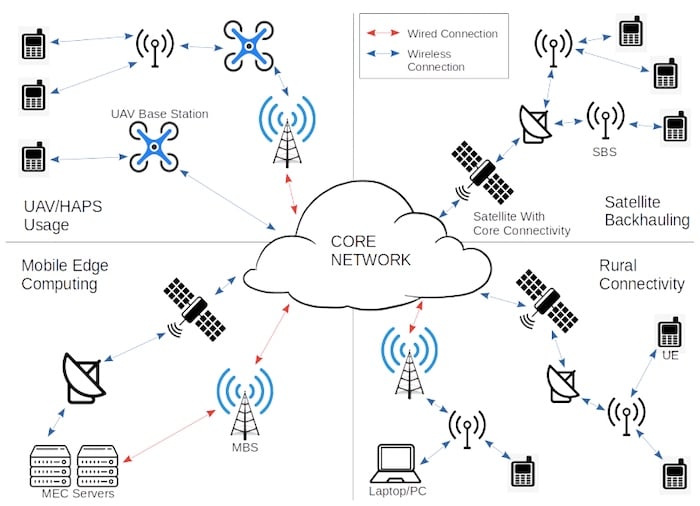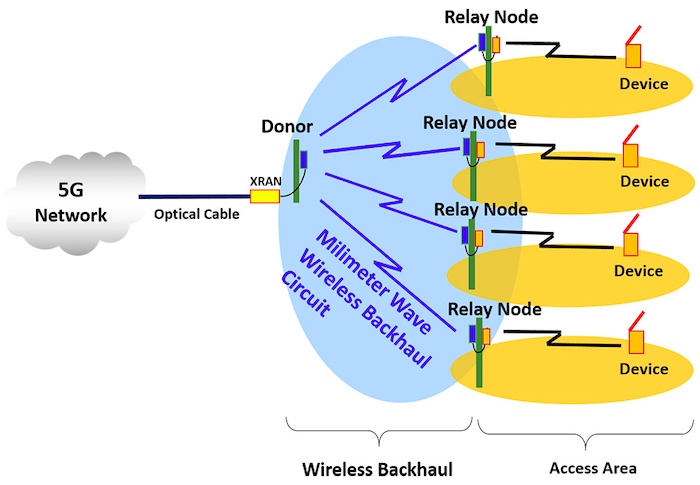

5G Backhaul May Move Data From Base Stations to a Core Network
source link: https://www.allaboutcircuits.com/news/5g-backhaul-may-move-data-from-base-stations-to-core-network/
Go to the source link to view the article. You can view the picture content, updated content and better typesetting reading experience. If the link is broken, please click the button below to view the snapshot at that time.

News
5G Backhaul May Move Data From Base Stations to a Core Network
The future of 5G NR means moving into mmWave frequencies. What opportunities and challenges await operators in designing backhaul network services?
With 5G deployment moving toward a standalone (SA) mode of operation, industry leaders and researchers are beginning to take a serious look at various backhaul strategies. This would move 5G data from base stations to a core network.
Fiber backhaul, which has traditionally supported previous generations of wireless telephony and data services, is an option, but with the densification of 5G base stations, it may not be an optimal solution.
When considering the infrastructure hurdles of laying down fiber, wireless backhaul might become the mainstream option for 5G mmWave services. Still, there are challenges for various configurations using wireless backhaul.

Potential configurations for 5G mmWave connectivity. Image used courtesy of Tezergil and Onur
Today, we are digging into research that explores the opportunities and challenges associated with wireless backhaul.
Backhaul Developments Around the Industry
5G mmWave backhaul development is already underway. Kyocera Global and JMA Wireless recently signed a contract to jointly develop a wireless backhaul using a donor node that has access to fiber backhaul.

Building a wireless backhaul using donor base stations. Image used courtesy of Kyocera
Built using O-RAN interfaces, the multi-beam wireless backhaul technology will connect rural and suburban areas to support coverage areas where fiber infrastructure is a nonstarter.
This “last mile” wireless connection is said to reduce installation time; it's also relatively affordable, lightweight, and compact. Kyocera will develop the radio system while JMA will create the XRAN virtualized baseband.
Recent Support for Backhaul Access
Hardware support for backhaul access is also starting to appear on the market. For example, Movandi recently released its MV6055 chipset for use in the frequency range of 57–71 GHz. This frequency range (included in the 3GPP Rel 17 schedule) is critical to developing future mmWave backhaul.

Current and future frequency allocation for 5G telecommunications. Image used courtesy of Tezergil and Onur
Beyond terrestrial backhaul, a satellite is emerging as a serious contender for wireless backhaul. Recently, 5GRuralDorset successfully completed a “world first” link between a satellite network and a core network.
This uplink improves reliability by working in tandem with terrestrial connectivity and provides rural communities like Dorset next-generation communications access.
Considerations for Wireless Backhaul
Some key challenges stand in the way of an expanding mmWave infrastructure. These include frequency use, allocation of wireless resources, deployment and topology selection, service scheduling, and security of wireless backhaul.
Two main configurations exist to deploy 5G wireless services. Point-to-point links offer high bandwidth but are limited to line-of-sight. They also incur high costs because they require transceivers at every endpoint.
Point-to-multipoint is less costly to set up, supports non-line-of-sight connections, and requires only a transceiver at the MBS. However, the bandwidth is shared among the small base stations.

Two dominant topologies emerge for wireless connectivity. Image used courtesy of Tezergil and Onur
Wireless backhaul is setting the stage for 5G NR to open up markets in rural environments, provide robust satellite links, and enable new edge computing use cases.
First, the Effort to Popularize mmWave
Technology and services for 5G are projected to reach five trillion dollars by 2025. While these opportunities are lucrative, overcoming the challenges associated with backhaul may require developers to lean on both fiber and wireless technology.
In the meantime, many telecom players are trying to raise mmWave technology into the limelight in general. GSMA in particular is launching a global “accelerator initiative” that includes major industry players such as Ericsson, Qualcomm, Verizon, Telstra, NTT DOCOMO, and China Unicom. This accelerator program will spearhead projects to demonstrate “everyday business implementations and increase educational efforts.”
GSMA's new mmWave accelerator initiative may speed up the adoption of this technology since partners have agreed to share “mmWave Intelligence,” best practices, and use cases. GSMA hopes to have more news coming in time for MWC Barcelona in February 2022.
Recommend
About Joyk
Aggregate valuable and interesting links.
Joyk means Joy of geeK